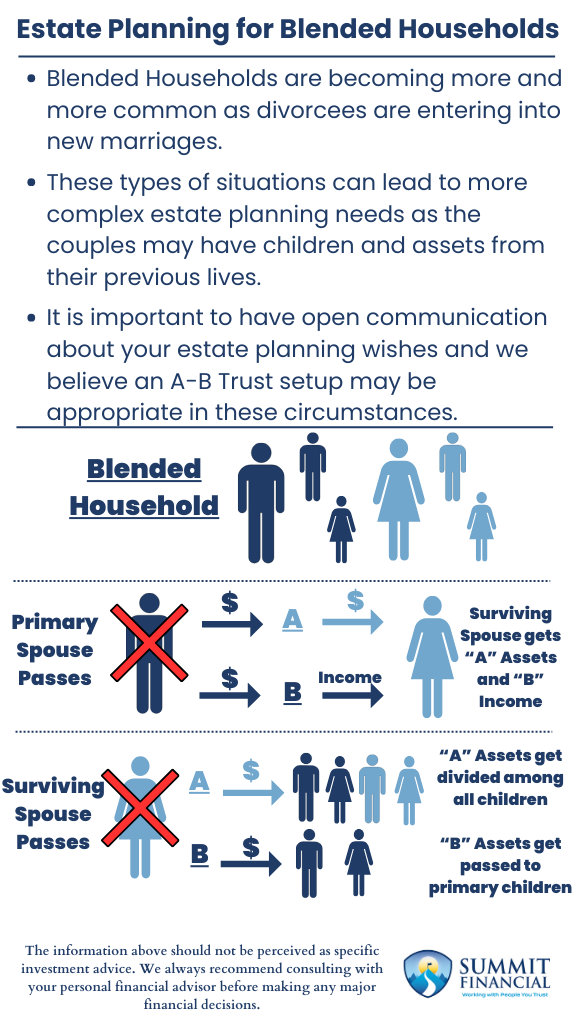The increasing prevalence of blended households, often formed by individuals entering new marriages after divorce, presents unique challenges in estate planning. Blended families typically involve complex family structures, with spouses potentially having children and assets from previous relationships. This can lead to intricate considerations when planning for the future distribution of these assets.
While we’ve previously explored estate planning basics like Beneficiary Designations and Will vs. Trust differences in our earlier blog posts, these sources can be great reference points for those who are looking to understand the basics of estate planning.
However, blended households often necessitate a more sophisticated approach. In these scenarios, spouses may prioritize leaving their assets to biological children rather than stepchildren, or even their surviving spouse, requiring specific strategies to ensure their wishes are met.
Every Couple Should Revisit Their Estate Plan After Marriage
Every couple should review their estate planning after their marriage, whether it is their first or their third marriage. This is an important time to review your beneficiary designations and update any wills/trusts that may already exist. It is important to have open communication about your estate planning wishes and we believe an A-B Trust setup may be appropriate in these circumstances.
The Challenge: Balancing Spousal Security with Children’s Inheritance
One spouse may have a lot of assets and want to make sure their kids receive these when they pass instead of a portion going to stepchildren, but they also do not want to leave their surviving spouse with no financial security. If no estate planning actions are taken, your estate will likely proceed through probate with your surviving spouse receiving the majority, if not all, of your assets.
When your surviving spouse passes away, the probate judge may decide to split the assets among all the family’s children, which means your assets may be passed to stepchildren. This concern is even stronger when only one of the spouses is responsible for a vast majority of the household’s assets.

A-B Trusts: A Potential Solution for Blended Households
An A-B Trust offers a structured approach to address the unique estate planning challenges faced by blended families. The naming of this estate plan tool is used to reference the two trusts that will be created.
The “A” trust will list the surviving spouse as the beneficiary so they will receive full control and ownership of those assets when their spouse passes. However, the “B” trust is set up to limit the control of the surviving spouse so that they can only use the assets according to the trust guidelines. Commonly, we see that the surviving spouse is allowed to live off the income generated from the “B” trust, or they must submit requests to the trustee to approve before assets are distributed.
When the surviving spouse passes, the assets in the “A” trust may be set up to be distributed evenly among all the family children. The “B” trust could be set up to pass the remaining assets to the children of the original owner. The “B” trust allows you to provide for your surviving spouse after you pass based on the trust guidelines, but then also make sure that the remaining assets get passed to your children only instead of being split amongst the stepchildren too.
Seeking Professional Guidance
This type of trust structure can be complex, so we recommend consulting with your estate planning attorney regarding your goals before committing to this plan. There may be other variables to consider that might make other strategies more efficient. We cannot stress enough how important it is to have effective communication with your spouse about your estate wishes.
Those who are later in life may have very valid reasons why they want to prioritize their children receiving assets, but those intentions should be clearly communicated to prevent unnecessary disagreements in the marriage. However, we believe the A-B trust structure allows for the control and flexibility to meet these unique wishes. It may not be the best solution for everyone, but we believe it is worthy of consideration for those who are planning estates for blended households.
Estate Planning for Blended Households- Considerations
- Blended Households are becoming more and more common as divorcees are entering into new marriages.
- These types of situations can lead to more complex estate planning needs as the couples may have children and assets from their previous lives.
- It is important to have open communication about your estate planning wishes and we believe an A-B Trust setup may be appropriate in these circumstances.
Financial Planning and Review Meeting
If you have any questions about flexible side hustles, your investment portfolio, retirement income planning, taxes, our 401(k) recommendation service, or anything else in general, please give our office a call at (586) 226-2100.
Please feel free to forward this commentary to a friend, family member, or co-worker. If you have had any changes to your income, job, family, health insurance, risk tolerance, or your overall financial situation, please give us a call so we can discuss it.
We hope you learned something today. If you have any feedback or suggestions, we would love to hear them.
Best Regards,
Zachary A. Bachner, CFP®
with contributions from Robert Wink, Kenneth Wink, and James Wink
If you found this article helpful, consider reading:
- Flexible Side Hustles
- Examining Pre-Tax and Post-Tax Contributions
- Why I Pursued my CFP® Certification
Sources:
- https://summitfc.net/how-to-make-the-most-of-estate-planning/
- https://summitfc.net/beneficiaries-and-estate-planning/
- https://www.legalzoom.com/articles/estate-planning-for-the-modern-blended-family
- https://trustandwill.com/learn/estate-planning-for-blended-families
- https://www.investopedia.com/terms/a/a-b-trust.asp


